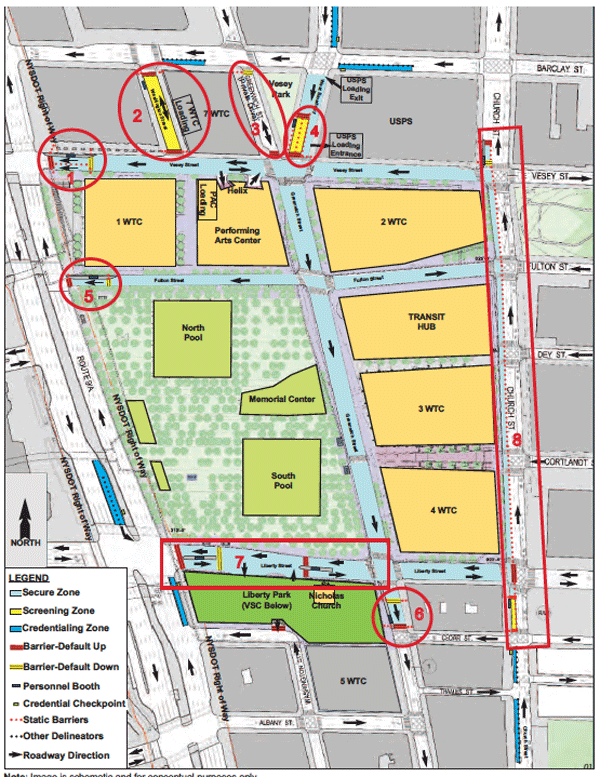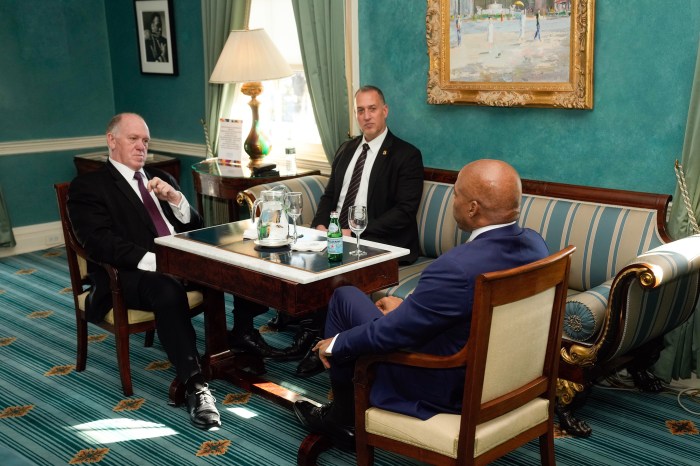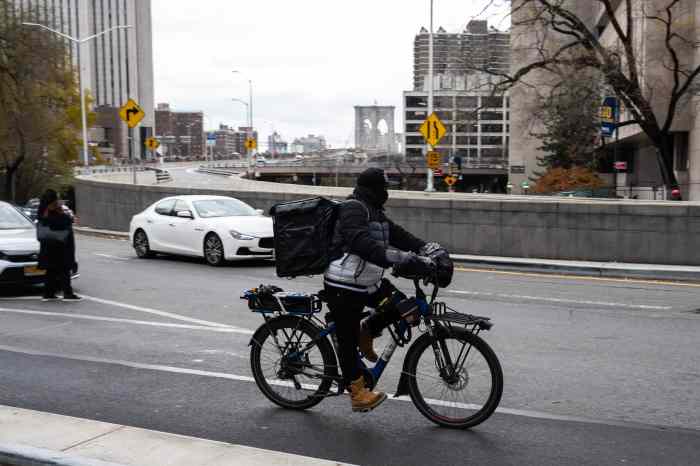BY JOSH ROGERS | Will it be a kinder, more flexible N.Y.P.D. protecting the World Trade Center when the new security plan begins to be implemented next month?
That message comes not from police officials trying to reassure the Downtown community, but from beleaguered W.T.C. area residents who have been fighting with police for years over what they say are excessively tight security restrictions.
Last week, several resident leaders said that for the first time in over a dozen years, they felt their voices were being considered.
“I’d like to say first of all thank you,” Mary Perillo, told W.T.C. police officials at a Community Board 1 meeting April 16. “I see the logjam moving, I see that you’re seeing what it’s like on the ground a little bit.”
Perillo lives across the street from the center and is president of the W.T.C. Neighborhood Alliance, which sued the N.Y.P.D. over the security plan, but their suit was dismissed in February.
One of the most surprising things about the meeting was that Dep. Inspector Kevin Burke, who heads the World Trade Center Command, and Lieutenant Tom Ferramosca, who helped develop the security plan, said that residents like Perillo right near the site could take taxis through the World Trade Center to get home.
“Traffic within the campus will be restricted, but people who have business within the campus will be permitted in and those people enrolled in [the Trusted Access Program], will be permitted in,” said Ferramosca.
Under TAP, vehicles and people that regularly enter the site including nearby residents will have passes to enter in vehicles.
The official line has always been that Greenwich St. would be open to at least some traffic, but the N.Y.P.D. always reserved the right to keep it closed, and few Downtowners had much hope the street would actually open anytime soon.

Map of World Trade Center security plan.
The beginnings of the plan will be in place at the end of next month when the 9/11 Museum opens May 21, and will be fully implemented by April 2015, when W.TC. 1 and 4 as well as the transit hub are expected to be open.
Inspector Burke said he is anticipating a visit by President Obama to the museum’s preview opening on May 15, although the White House had not yet given the final confirmation.
Once the museum opens to the public, pedestrians will have freer access to the 9/11 Memorial, which will no longer have the timed ticketing system. Officials with the Port Authority, owners of most of the W.T.C. said earlier this month that some of the barriers to the memorial at the south end will be removed, which will allow residents and visitors to traverse between Battery Park City and the Financial District as they experience the memorial.
Inspector Burke said pedestrians and bicyclists in most cases will be able to move freely within the complex by next year “absent something significant that stands out to the officer.”
He said there will be “hiccups” to the program at the beginning, but he said he is open to continued dialogue with the community board on either an informal basis or as part of a task force as C.B. 1 requested.
Currently there are 185 N.Y.P.D. officers assigned to the W.T.C. That number will expand, but Burke said it will likely be less than the 600 called for in the Environmental Impact Statement.
Port Authority police will patrol the underground areas near the PATH commuter line. Burke said about 60 Port police officers are currently being trained at the N.Y.PD.’s police academy.
Tour buses visiting the museum will enter on Liberty St., which has been a long-term concern of C.B. 1.
“And you anticipate a row of buses lining up under our windows with fumes and noise,” asked Pat Moore, who lives across the street and is chairperson of the board’s Quality of Life Committee.
“No absolutely not, that’s been one of our concerns for some time now,” said Ferramosca,
Officials hope that by scheduling truck deliveries to the office buildings and using a two-step entry process it will avoid traffic problems in the area. Credentialing vehicles looking to enter the site is expected to be done in “a matter of seconds,” and screening “in the vicinity of two minutes or so,” said Ferramosca.
After the meeting, Moore also said that she now felt for the first time since 9/11, that police officials were willing to listen to her and other residents.
The shift undoubtedly has something to do with the de Blasio administration, which took over in January, although to be sure, the change is more in tone than in substance.
As a mayoral candidate last year, Bill de Blasio told Downtown Express that he was not inclined to make changes to the W.T.C. security plan given the N.Y.P.D.’s anti-terrorism track record, but he also said he would not worry about the political consequences if he or his police commissioner thought adjustments were warranted.
“If you do that and God forbid, that becomes the beginning of a problem, yes, you’ll pay the price for it many times over, but that’s a choice you make in leadership every single day on a host of levels,” he said then. “Terrorism is maybe the most dramatic example, but you make those decisions all the time.”
Dan Alterman, who’s lived and worked in Lower Manhattan for decades and was an attorney in the residents’ lawsuit, said in a phone interview this week that Downtowners are certainly aware of the potential dangers to the WT.C. particularly in light of security breaches in recent months , but it doesn’t have to be an “either or” choice between security and freer movement.
He said the residents’ group made the right decision not to appeal the lawsuit’s dismissal and he was pleased to hear police are now relating well with people the neighborhood.





































